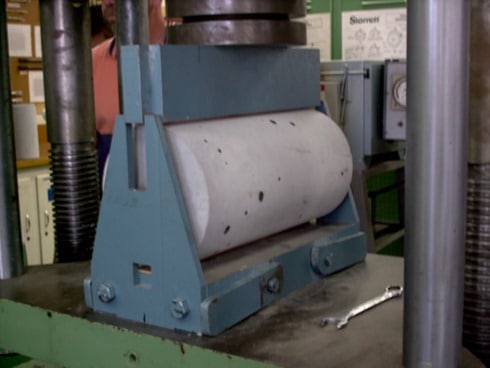Aim: To calculate the splitting tensile of concrete
Theory:
Tensile strength of concrete is the most fundamental and significant property among many. Splitting tensile strength test on concrete cylinder is a technique to resolve the tensile strength of concrete.
The concrete is very fragile in stress because of its fragile character and is not anticipated to oppose the direct tension. The concrete therefore gets splits and cracks when they are exposed to tensile forces. Therefore, it is essential to establish the tensile strength of concrete to decide the load at which the concrete members may crack or split.
Equipments:
Compression testing machine; two packing strips of plywood 30 cm long and 12mm wide.

Sampling of the Concrete Cylinder:
The cylinder mould has to be made of metal at least 3mm thick. Each one of the mould is able of being opened longitudinally to make possible the elimination of the sample and is given with resources of keeping it shut while being utilized. The mean internal diameter of the mould or the cast has to be of 15 cm ± 0.2 mm and the height is 30 +/- 0.1 cm. Each one of the mould is given with a metal base plate mould and base plate has to be thoroughly coated with a thin film of mould oil before use, in order to avert bond of solid.
Tamping Bar:
The tamping bar refers to a steel bar of 16 mm diameter , 60 cm in length and bullet pointed at the lower end.
Compacting of Concrete:
The test sample has to be created soon as feasible after the concrete is filled into the mould in many layers roughly 5 cm deep. Each one of the layer is compressed by means of hand or by vibration.
Compacting by Hand:
When compacting by hand, the standard packing/tamping bar is utilized and the stroke of the bar ought to be dispersed in a uniform way. The quantity of strokes for every layer ought at least 30. The stroke ought to enter into the basic layer and the base layer ought to be rodded all through its profundity. After top layer has been compacted,the surface of the solid ought to be done level with the highest point of the mould,using a trowel and secured with a glass or metal plate to forestall vanishing.
Curing of specimen:
The test example ought to be put away in a place at a temperature of 27° +/ – 2°C for 24 +/ – 0.5 hrs. from the time expansion of water to the dry fixings. After this period the example ought to be stamped and expelled from the would and promptly submerged in clean crisp water or soaked lime arrangement and kept there until taken out only before the test. The water or arrangement in which the example s are kept ought to be reestablished at regular intervals and ought to be kept up at a temperature of 27° +/ – 2°c.
Concrete cylinder 15 cm diameter and 30cm long
Note: Cast 6 cylinders (3 for compression test and 3 for split test)
Procedure of Splitting Tensile Test:
- Take the wet sample from water following 7 days of curing
- Wipe out water from the surface of sample
- Draw polar lines on the two finishes of the sample to guarantee that they are on the same pivotal place.
- Take note of the weight and measurement of the sample
- Set the pressure testing machine for the required range.
- Keep the plywood strip on the lower plate and place the sample
- Adjust the sample so that the lines set apart on the closures are vertical and focused over the base plate.
- Put the other plywood strip over the sample.
- Cut down the upper plate to touch the plywood strip.
- Apply the load incessantly without stun at a rate of around 14-21kg/cm2/minute (Which compares to an aggregate heap of 9900kg/moment to 14850kg/minute)
- Note down the breaking load(P)
Calculation:
As per IS456, split tensile strength of concrete.= 0.7Fck
The splitting tensile strength is calculated using the formula
Tsp = 2P/ pi DL
Where P = applied load
D = diameter of the specimen
L = length of the specimen
Therefore P = Tsp x pi DL/2
Expected load = P x f.s
Range to be selected is…………..
Split Tensile Strength
T= 2P/ pi DL
Report
(I) Date of test
(II) Identification mark and size of the specimen
(III) Age of test specimen and date of test
(IV) Curing history,as detailed earlier
(V) Weight of specimen in kg .
(VI) Type of fracture face,if they are unusual.
RESULT
Splitting tensile strength of given concrete =……………….N/mm²
